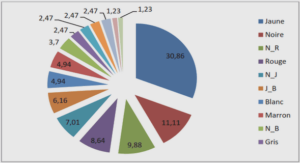African Americans struggle for emancipation in Maya Angelou‟s
The Causes of the Struggle
Racial discrimination and segregation
Racial discrimination and segregation is consistently another form of bondage. In soul on ice, Eldridge Cleaver persists in believing that “racial segregation is the steady hidden continuation of slavery on a higher plane”2 . As a matter of fact, the American Heritage Dictionary of the English language defines segregation as” the policy and practice of the social separation of races, as in school, housing, industry, especially discriminatory practices against non whites in a predominantly white society.”3 This definition is widely illustrated in both novels. In I know why the caged bird sings, at the second chapter, Maya Angelou, the narrator, presents a very segregated city, stamps. This setting is so segregated that, Maya, as a little girl, does not know what white people look like though they live half mile away from her grandmother‟s store. The only time that she knows that, they are white people are when black women, after a long day of toil at white people bring their laundries before her grandmother house Annie Henderson. This open racial separation makes Maya wonder if they are really human beings: I know for instance they had an opening their things and peeing and that white women‟s breasts weren‟t built into their dresses, as some people said , because I saw their brassiers in their baskets. But I could force myself to think them as people.”(CBS, p.25) Furthermore, despite their living separately, white community stands as a thread at black community. To Angelou, other than that they are different, to be scared, and 2 Cleaver, “soul on ice” in Gates Henry Louis Jr, Bearing Witness, New York: pantheon Books, 1991, p.171. 3 The American Heritage Dictionary of The English language 7 in that scare is included the hostility of the powerless against the powerful, the poor against the rich and the worker against the worked. William Dubois though he has never experienced the evil of racial separation in dwelling, has made a scientific, consistent and artful description of this geographical separation. To him, it is possible in almost southern community to mark out a physical colour line on the map on the one side, which whites live, and on the other Negroes. The winding and intricacy of the geographical colour separation varies, of course, in different communities. He surely adds that he knows that some towns where the straight lines drawn in the middle of the mainstream separates nine tenth of the whites from nine tenth of the Blacks. In other towns, the old settlements of the whites have been circled by a large band of Blacks; in still other settlements, blacks have sprung up amid surrounding. Most often, in cities, each street has its own distinctive colour, and only now and then does the colour meet, even the country something in this segregation is noticeable mainly in the black belt. Yet this racial segregation is not only limited in dwelling, it spreads as far as to some public places, as in restaurants particularly in the south. And this denial to the blacks to have access to restaurants fuels the four blacks students anger, who courageously sit down at a white only department store lynch counter in Greensboro , North Carolina. This Woolworth‟s counter is but one of the many segregated facilities in the southern states where African Americans have been expelled from activities as eating, swimming and drinking by whites, who not only oppose equal treatment but also afraid of any possibility of physical contact. The restaurant goes on refusing these students services; they remain seated all the same until it closes down. They return each morning for the next five days to occupy the lynch counter faced by a mob of angry white residents that refuse to serve them a cup of coffee, the students carry on their protest until they force the store to close down.
Assaults against Blacks
Before scrutinizing the main causes of the violent assault let us have a look how and why African Americans were assaulted during slavery time. Historian Kenneth M. Stamps describes the coercion in slavery without the power to punish, which the state conferred upon master, bondage could not have existed. By comparison, all are the techniques of control of secondary importance. According to both historians David Brown Davis and Eugene Genovese who won major awards for their work on slavery, treatment of slaves was both tough and inhuman. Whether working or walking in public people living as slaves were regulated by legally authorized violence. David Davis makes the point that some aspects of the plantations slavery took o welfare capitalist. Even the most human masters knew that only by threat of violence could urge slave to work to sunrise to sunset. Frequent public whipping reminded every slave of the penalty for inefficient labor revolt conduct or refusal to accept the authority of a master. Slaves who worked and lived on plantation were the most frequently punished and this punishment could be done by masters, wives or their children. Frederick retraces: Colonel Lloyd had three children –Edward Murray and Daniel- and three sons-in laws Mr. Winder, Mr. Nicholson and Mr. Loundes. All of these lived at the Great House Farm and enjoyed the luxury of whipping the servant when they pleased, from older Barney down to William Wilder the coach driver. 7 They were also punished with variety of objects and instruments such as weapons knives, guns. But the whip was the most common tool used against slaves. Douglass as a former slave describes witnessing a woman lashed before her children an overseer: “when the poor woman was untied her back was covered with blood. She was whipped terribly whipped”. According 7 The Life of Frederick Douglass, Op.cit.p.11 19 to Douglass, slaves were determined not to let masters whip them and would resist them when they attempt it. You can shoot me said a slave to Rigby Hopkins but you can‟t whip me. Slaves were punished for a variety of reasons, most of the time, it was working too slow, violating the law such as running away, leaving the plantation without the permission or refusing to respect orders demanded to them. But for Douglass, a look, a word, and gesture never failed to be considered as an offense by slave holders as well. The law made to punish the whites for punishing their slaves was weakly enforced or could be very easily avoided. Douglass witnesses how his master‟s overseer remained unpunished after shooting at one of his slaves who refused to be whipped. His horrible crime was not even submitted to judicial investigation. Since it was committed in the presence of slaves, therefore the responsible of the bloodiest murder reminded “unwhipped of justice and uncensored the community in which he lives.” Slaves were in constant stands of losing members of their families when masters decided to sell them for profit. . And Martin Luther King, Jr. retraces it in his speech Why we can‟t wait fathers and mothers were sold from their children and children were bargained away from their parents. Young girls were in many cases sold to become the breeders of fresh generations of slaves. The slaves holders of America had devised with almost scientific precision their system for keeping the Negro defenseless, emotionally and physically.”(Image of the Negro p106) However, with the ending of slavery and the decline of the Republican party dominated by Northerners who maintained a presence in the South and established agencies to oversee the transition from slavery to freedom and chiefly with the strengthening of the Southern Democrats, African Americans became the easy target of whites. Whites, therefore could hang, lynch Blacks without any charge or convict. In I Know Why The Caged Bird Sings, 20 lynching constitutes a big danger and legitimate fear in the minds of African Americans in Arkansas. Early in the novel, we witness how Mrs. Henderson hides a would-be lynching victim and provides him with supplies for his journey, though she risks her own security to do so. Another incident of lynching compels Maya and her brother to hide their uncle, Willie; after an unknown young black is charged of “messing with a white woman” Maya depicts the emotional and psychological impact of the fear of lynching as she felt it: Even after the slow drag of years, I remember the sense of fear which filled my mouth with hot, dry, air and made my body light ….We were told to take the potatoes and onions out of their bins and knocked out the dividing walls that kept them apart .Then with a tedious and fearful slowness, uncle Willie gave me his rubber tipped and bent down to get into the now enlarged empty. It took forever before he lay down flat and covered him with potatoes and onions, layer upon layer, like a casserole. Grandmother knelt down praying in the darkened store ( C B S P.14 -15) Furthermore, Maya describes the frustration and the humiliation her family feels during this situation. She questions the absurdity of lynching. She asks why a crippled old man should be urged to spend a whole night in a bin full of onions and potatoes because of some unnamed crime have been committed by unknown people. Like Angelou Marita Golden too relates this horror of lynching through Naomi‟s cousin, a boy just fourteen years old.. He had been lynch while playing with some white kids and one of the girls argues that Naomi‟s cousin has touched her private parts which angers all white men of Spring Hope. They rush at Jimmy‟s house and drag him away,
Dedication |






